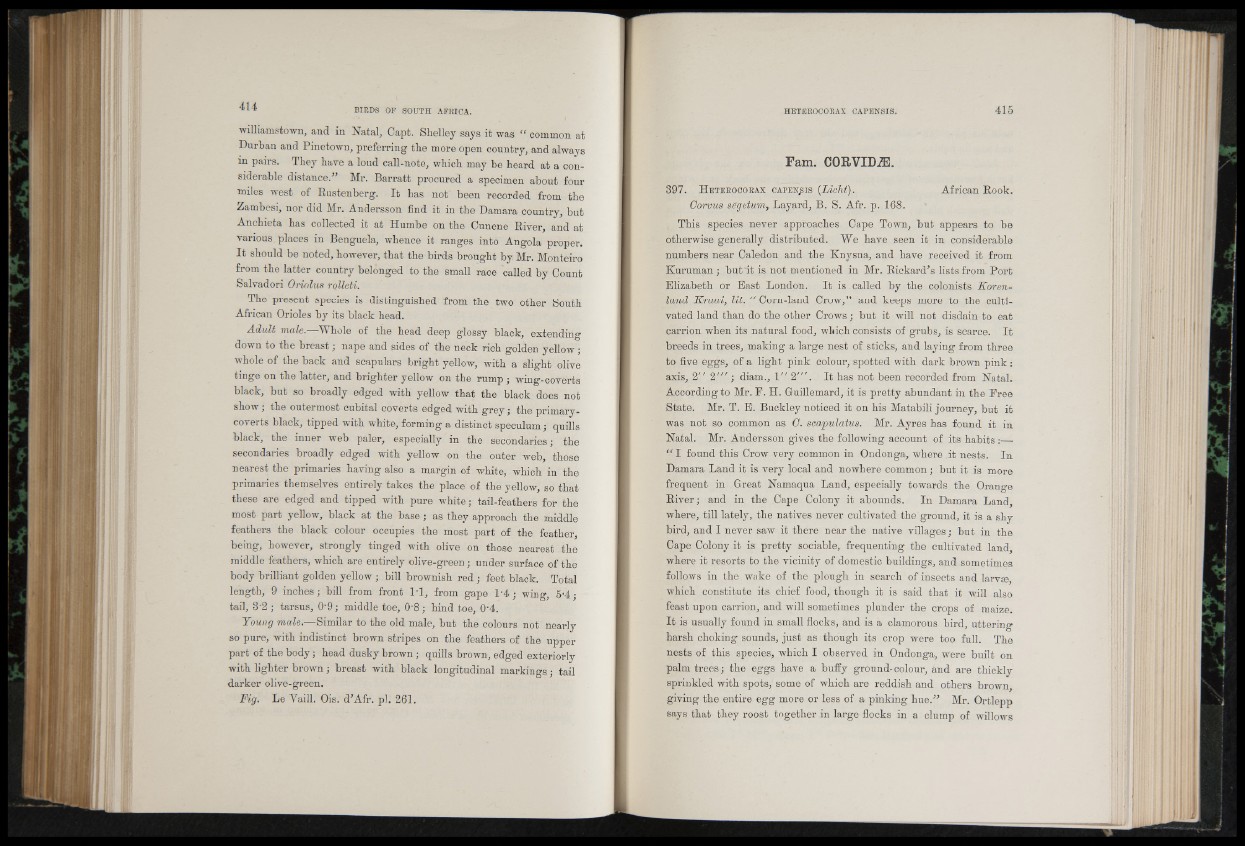
williamstown, and in Natal, Capt. Shelley says it was “ common at
Durban and Pinetown, preferring the more open country, and always
in pairs. They hare a loud call-note, which may be heard at a considerable
distance.” Mr. Barratt procured a specimen about four
miles west of Rustenberg. It has not been recorded from the
Zambesi, nor did Mr. Andersson find it in the Damara country, but
Anchieta has collected it at Humbe on the Cunene River, and at
various places in Benguela, whence it ranges into Angola proper.
It should be noted, however, that the birds brought by Mr. Monteiro
from the latter country belonged to the small race called by Count
Salvadori Oriolus rolleti.
The present species is distinguished from the two other South
African Orioles by its black head.
Adult male.—Whole of the head deep glossy black, extending
down to the breast; nape and sides of the neck rich golden yellow;
whole of the back and scapulars bright yellow, with a slight olive
tinge on the latter, and brighter yellow on the rump ; wing-coverts
black, but so broadly edged with yellow that the black does not
show ; the outermost cubital coverts edged with grey ,• the primary-
coverts black, tipped with white, forming a distinct speculum; quills
black, the inner web paler, especially in the secondaries; the
secondaries broadly edged with yellow on the outer web, those
nearest the primaries having also a margin of white, which in the
primaries themselves entirely takes the place of the yellow, so that
these are edged and tipped with pure white; tail-feathers for the
most part yellow, black at the base; as they approach the middle
feathers the black colour occupies the most part of the feather,
being, however, strongly tinged with olive on those nearest the
middle feathers, which are entirely olive-green; under surface of the
body brilliant golden yellow ; bill brownish red; feet black. Total
length, 9 inches; bill from front P I, from gape 1-4; wing, 5-4;
tail, 32 ; tarsus, 0'9; middle toe, 0'8; hind toe, 0‘4.
Young maZe.#Similar to the old male, but the colours not nearly
so pure, with indistinct brown stripes on the feathers of the upper
part of the body; head dusky brown; quills brown, edged exteriorly
with lighter brown; breast with black longitudinal markings; tail
darker olive-green.
Fig. Le Vaill. Ois. d’Afr. pi. 261.
Fam. CORVIDiE.
397. Heterocorax capeNjSIS (Licht). African Rook.
Oorvus sSgetum, Layard, B. S. Afr. p. 168.
This species never approaches Cape Town, but appears to be
otherwise generally distributed. We have seen it in considerable
numbers near Caledon and the Knysna, and have received it from
Kuruman; but it is not mentioned in Mr. Rickard’s lists from Port
Elizabeth or East London. It is called by the colonists Koren-
land Kraai, lit. “ Corn-land Crow,” and keeps more to the cultivated
land than do the other Crows; but it will not disdain to eat
carrion when its natural food, which consists of grubs, is scarce. It
breeds in trees, making a large nest of sticks, and laying from three
to five eggs, of a light pink colour, spotted with dark brown pink :
axis, 2" 2" ' ; diam., 1" 2'” . It has not been recorded from Natal.
According to Mr. P. H. Guillemard, it is pretty abundant in the Free
State. Mr. T. E. Buckley noticed it on his Matabili journey, but it
was not so common as 0. scapulatus. Mr. Ayres has found it in
Natal. Mr. Andersson gives the following account of its habits :—
“ I found this Crow very common in Ondonga, where.it nests. In
Damara Land it is very local and nowhere common ; but it is more
frequent in Great Namaqua Land, especially towards the Orange
River; and in the Cape Colony it abounds. In Damara Land,
where, till lately, the natives never cultivated the ground, it is a shy
bird, and I never saw it there near the native villages; but in the
Cape Colony it is pretty sociable, frequenting the cultivated land
where it resorts to the vicinity of domestic buildings, and sometimes
follows in the wake of the plough in search of insects and larvae
which constitute its chief food, though it is said that it will also
feast upon carrion, and will sometimes plunder the crops of maize.
It is usually found in small flocks, and is a clamorous bird, uttering
harsh choking sounds, just as though its crop were too full. The
nests of this species, which I observed in Ondonga, were built on
palm trees; the eggs have a buffy ground-colour, and are thickly
sprinkled with spots, some of which are reddish and others brown
giving the entire egg more or less of a pinking hue.” Mr. Ortlepp
says that they roost together in large flocks in a clump of willows